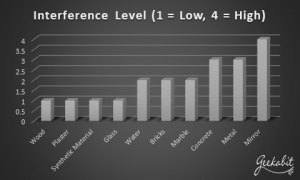This week’s blog is the last in our series on Wi-Fi interference and what you can do about it. So far we’ve covered physical causes of Wi-Fi interference, how electrical devices can affect Wi-Fi through frequency interference and today we’re talking about capacity and coverage.
How does capacity affect Wi-Fi interference?
Capacity problems are most commonplace in corporate environments like offices. A potential issue that these environments might face is having too many users per broadcast device. This causes a capacity overload and that’s when you start to run into Wi-Fi problems.
Each Wi-Fi broadcast device, e.g. a router or access point, has a finite amount of bandwidth. This bandwidth is divided by the number of wireless devices connecting to it. So if only 10 devices are connected, then the bandwidth for that router will be divided by 10. It’s almost irrelevant how fast the internet connection is – If 50 people try to connect then the bandwidth is going to split 50 ways.
Ways to avoid issues with capacity and bandwidth, is to make sure that you don’t have just one router or access point serving an area of high density. If you have a lot of users or users with multiple devices in a certain area, then make sure you have the necessary number of broadcast devices. You might find our blog on ‘How Many Access Points do I need?’ helpful for this.
How does coverage affect Wi-Fi interference?
It’s not just about the capacity in an area, you also need to consider the distance that people are needing to connect across. Getting Wi-Fi coverage right is just as important as capacity.
We all know that that closer we are to a broadcasting device, the stronger and more reliable the signal is going to be. If you know that there will be users in a particular area of your office or business that will need to connect, then make sure that there is a device close-by enough to transmit a strong signal.
Coverage isn’t all about distance, it’s also about whether your devices are installed effectively. For example, it’s pointless installing an access point in close range to users if it’s pointing in the wrong direction, or hidden behind something. Wireless broadcast devices like routers or access points emit their signal in certain directions. Obviously you can’t see what way the radio signals are going so make sure that devices are installed properly. Access points that are hidden behind shelves, or wedged in ceiling tiles are not going to work the way they were intended to. Always check the instructions and manufacturers guide when installing any hardware so that they work effectively and reach the maximum coverage possible. If you’re not sure, then ask the experts!
What can we conclude on the types of Wi-Fi interference and their resolutions?
Wi-Fi has come a long way since it first arrived in our lives, and while the gap between wireless internet and wired is certainly closing, there’s always going to be some inferiority for Wi-Fi when comparing the two.
Some of the resolutions we’ve covered in this series of blogs on Wi-Fi Interference are:
- Check for physical obstruction risks such as metal and concrete, and place your broadcast devices strateigically to mitigate risks.
- Check your kit and upgrade where necessary. Devices that can use the 802.11ac frequency with dual band functionality are really useful for scenarious where you need to swap from 2.5Ghz to 5Ghz.
- Always check for firmware upgrades. A bit like how you update the apps on your smartphones, manufacturers are constantly trying to better their performance by enhancing the software that runs them so do keep a watch for updates which are often free.
It’s so important to take careful consideration when designing your Wi-Fi network. If you don’t feel confident assessing your environment for the potential issues in this series of Wi-Fi interference blogs, then consider calling in the experts. Our Wi-Fi engineers can carry out a Wi-Fi survey followed by planning and design and finished with expert installation for effective and reliable Wi-Fi.




